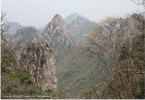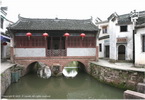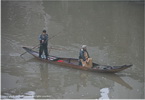|
Anhui, with a
population of over 59 million, is an inland province in
Southeast China. It stretches over the Yangtze River and
Huai River, and is adjacent to six provinces of Jiangsu,
Zhejiang, Jiangxi, Hubei, Henan and Shandong.
Hefei
City, the capital of the province, has
many attractions as a result of its
2,000 years of history.
|
 |
Covering an area of 130,000 square
kilometers (50,200 square miles), Anhui boasts of abundant tourism
resources, and is a top tourist
attraction among many in the
Southeast, such as: the amazing Mount Huangshan, famous for its towering
pines, precipitous stones, wonderland cloud-sea and hot springs; Mount
Jiuhua, one of the four famous Buddhist Mountains in China; Mount Tian
Zhu, also a well-known scenic spot. The magnificence of these peaks is
simply stupendous. Standing on top of any one of these peaks would
overwhelm most trekkers with a sight to behold.
In addition to the
beautiful mountain scenery, the well-preserved
ancient villages in Southern Anhui are derived
from the Ming and Qing Dynasties (1368 - 1911).
The most impressive ones are in Xidi and Hongcun
Ancient Villages in Yixian County near Mount
Huangshan. |
 |
Anhui Countryside |
|
|
|
|
Covering an area of 130,000
square kilometers, Anhui
province boasts of abundant
tourism resources, and is a top
tourist attraction among many in
the Southeast. |
|
|
|
|
 |
Bao's
Family Garden |
xxxxxxxxxxxxx |
GPS: |
29.86255,
118.37015 |
|
Built in the Qing Dynasty (1644
- 1911), Bao's Family Garden is
in Shexian, Huangshan, Anhui
Province. It was one of the
three most famous private
gardens in southern China in the
Qianlong Period (1735 - 1796)
and Jiaqing Period (1796 -
1820). |
|
|
|
|
 |
Chengkan |
|
GPS: |
29.92299,
118.28477 |
|
Chengkan Village, about 40km (25
miles) to the north of Huangshan
City in Anhui Province, is a
well-preserved ancient village
with appealing scenery of
mountains and waters and age-old
residences with rich local
characteristics. |
|
|
| |
|
|
|
|
|
| |
Baolun Hall |
|
GPS: |
29.92315,
118.28419 |
|
A must-see spot in Chengkan
Village. It is part of Luo
Dongshu's Ancestral Temple,
built by Luo's descendants to
worship him. Luo Dongshu was a
noted scholar as well as a
hermit at the end of the Song
Daynasty who made a great
contribution to the Luo Family
in Chengkan. |
 |
|
|
|
|
|
|
|
Chengkan village |
|
GPS: |
29.92299,
118.28477 |
|
Chengkan Village has over 150
ancient residences, among which
21 are major cultural relics
under state protection. |
 |
|
 |
Hongcun |
|
GPS: |
30.00068,
117.99144 |
|
With a 900 years existence,
Hongcun Ancient Village is
designated a World Heritage Site
by UNESCO in 2000. The village
layout resembles body of an ox,
with Leigang Hill being the
'head'. |
|
|
|
|
 |
Huangshan |
|
GPS: |
30.1378,
118.16511 |
|
Of all the notable mountains in
China, the Huangshan Mountain,
aka Yellow Mountain, is probably
the most famous and can be found
in the south of Anhui Province. |
|
|
|
|
 |
Nanping |
|
GPS: |
29.89982,
117.90674 |
|
The village is sited in the
southwest of Yixian County. It
has a history of almost one
thousand years. There are about
300 ancient Hui-style houses and
buildings built in Ming and Qing
Dynasties, as well as 36 ancient
wells and 72 lanes. |
|
|
|
|
 |
Qiankou |
|
GPS: |
29.86629,
118.30081 |
|
Qiankou town of Huizhou district
covers an area of 16,000 square
meters and centralizes 10
representative buildings of the
Ming dynasty scattered in
Huizhou. It remains Dwelling
Houses of Ming period. |
|
|
| |
|
|
|
|
|
|
|
Dwelling houses |
|
GPS: |
29.86838,
118.29493 |
|
The Qiankou Residence is an
ancient architecture complex in
the style of the Ming (1368 -
1644) and Qing (1644 - 1911)
dynasties. It is also widely
known as Zixia Mountain Villa
because it lies at the foot of
Mt. Zixia in Qiankou Town. |
 |
|
|
|
|
|
| |
Xiajianta |
|
GPS: |
29.86226,
118.30142 |
|
xx |
 |
|
 |
Shexian |
|
GPS: |
29.86137,
118.41534 |
|
In the northeast part of
Huangshan City locates a
famous historical and cultural
city – Shexian County.
Surrounded by green mountains
and crystal water, it is rich in
cultural relics, residences,
memorial temples, and memorial
arches. |
|
|
| |
|
|
|
|
|
| |
Shexian Old City |
|
GPS: |
29.86618,
118.43586 |
|
The old city of Shexian, known
as Huizhou Ancient City, is
composed of Fu Cheng and Xi'an
Cheng. Fu Cheng was originally
built in the late Sui Dynasty
(581-618), and enlarged in Tang
Dynasty (618-907) to the later
scale. |
 |
|
|
|
|
|
| |
Doushan lane |
|
GPS: |
29.86729,
118.43847 |
|
Some old streets such as Doushan
Street, Zhongshan Lane and Dabei
Street have basically kept their
features of Ming-Qing Dynasties. |
 |
|
|
|
|
|
|
|
Xuguo archway |
|
GPS: |
29.86519,
118.43565 |
|
According to folklore, Xuguo
took advantage of the emperor's
vague instructions about the
project and constructed an
eight-posted archway, in spite
of the fact that only royal
families were allowed to build
this kind of architecture. |
 |
|
 |
Tang Mo |
|
GPS: |
29.86983,
118.33678 |
Tangmo Village was rated as one
of the top ten 'must see' famous
scenic spots in Huangshan City.
It was constructed originally in
the Tang Dynasty (618-907). It
reached its height of prosperity
in both the Ming (1368-1644) and
Qing (1644-1911) dynasties. |
|
|
|
|
 |
Tangyue
Archways |
|
GPS: |
29.86684, 118.37008 |
|
The Tangyue Memorial Archway
group is composed of seven
arches. It is located on the
road at the entrance of the
Tangyue village in the west of
Shexian County. The arches
represent, in successive order,
loyalty, filial piety, women's
chastity and charity. |
|
|
|
|
 |
Tunxi |
|
GPS: |
29.6961,
118.31532 |
|
Tunxi Ancient Street, with
hundred years history, is the
best persevered old street in
China in the style of the
Southern Song Dynasty, Ming and
Qing Dynasties. It is composed
of 1 main street, 3 bystreets
and 18 alleys with more than 300
Hui-style architectures. |
|
|
| |
|
|
|
|
|
| |
Tunxi city |
|
GPS: |
29.6961,
118.31532 |
|
Ringed by low-lying hills, the
old trading town of Tunxi also
called Huangshan Shi or
Huangshan City is the main
springboard for trips to
Huangshan and the surrounding
Huizhou villages. Compared with
the region’s capital, Hefei,
Tunxi makes for far a better
base. |
 |
|
|
|
|
|
|
|
Tunxi Old street |
|
GPS: |
29.70826,
118.3064 |
|
It dates back to the Song
Dynasty (960-1279), with
centuries-old history. Tunxi Old
Street is paved with maroon
flagstones with a total length
of 1,273 meters (about 1,392
yards), of which 895 meters
(about 979 yards) is the
pedestrian commercial streetl. |
 |
|
 |
Xidi |
|
GPS: |
29.89904, 117.99295 |
|
Xidi Ancient Village is about
40km south of Huangshan
Mountain. Encircled by green
hills, two streams flow through
the village from the north and
the east converging at Huiyuan
Bridge. The village has two main
streets and about 99 lanes paved
with cobblestones or black
stones. |
|
|
|
|
|
|
|
|
|
|






















